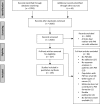Adhesion molecules in peritoneal dissemination: function, prognostic relevance and therapeutic options
- PMID: 27074785
- PMCID: PMC4884568
- DOI: 10.1007/s10585-016-9791-0
Adhesion molecules in peritoneal dissemination: function, prognostic relevance and therapeutic options
Abstract
Peritoneal dissemination is diagnosed in 10-25 % of colorectal cancer patients. Selected patients are treated with cytoreductive surgery and hyperthermic intraperitoneal chemotherapy. For these patients, earlier diagnosis, optimised selection criteria and a personalised approach are warranted. Biomarkers could play a crucial role here. However, little is known about possible candidates. Considering tumour cell adhesion as a key step in peritoneal dissemination, we aim to provide an overview of the functional importance of adhesion molecules in peritoneal dissemination and discuss the prognostic, diagnostic and therapeutic options of these candidate biomarkers. A systematic literature search was conducted according to the PRISMA guidelines. In 132 in vitro, ex vivo and in vivo studies published between 1995 and 2013, we identified twelve possibly relevant adhesion molecules in various cancers that disseminate peritoneally. The most studied molecules in tumour cell adhesion are integrin α2β1, CD44 s and MUC16. Furthermore, L1CAM, EpCAM, MUC1, sLe(x) and Le(x), chemokine receptors, Betaig-H3 and uPAR might be of clinical importance. ICAM1 was found to be less relevant in tumour cell adhesion in the context of peritoneal metastases. Based on currently available data, sLe(a) and MUC16 are the most promising prognostic biomarkers for colorectal peritoneal metastases that may help improve patient selection. Different adhesion molecules appear expressed in haematogenous and transcoelomic spread, indicating two different attachment processes. However, our extensive assessment of available literature reveals that knowledge on metastasis-specific genes and their possible candidates is far from complete.
Keywords: Adhesion; Colorectal cancer; Hipec; Peritoneal metastases; Predictive biomarkers; Prognosis.
Figures




References
Publication types
MeSH terms
Substances
LinkOut - more resources
Full Text Sources
Other Literature Sources
Medical
Research Materials
Miscellaneous

